Since anime is such an art, quality visuals reign supreme in the industry. It’s obvious for sure, but no matter how good one’s art is, it doesn’t matter if it’s not put together well. If you think about some of your favorite moments from anime I’m sure much of it was due to good direction. It’s up to the series directors to maintain quality control while organizing the staff and tools they have.
As such, it’s very important for studios to find the right directors. If you want the best representation of your work, you make sure to find someone who shares that vision. So for anyone watching Mieruko-chan, you may have noticed that the animation for this series is executed in a specific way. That’s because Mieruko-chan’s director, Ogawa Yuki, uses unique camera work and framing derived from his cinematographic experience.

Cinematic History
While they are historically not as popular as the voice-actors, directors can still be well-known. This comes from creating memorable moments within a show or movie that impresses viewers. Ogawa Yuki is a director that has been in the industry for a decent amount of time. You may know some of his previous works, such as Saekano (2015), My First Girlfriend is a Gal (2017), or Interspecies Reviewers (2020).
So let’s discuss how he balances his vision with establishing the setting. Films themselves are already difficult enough to direct, but maybe even more so when it’s animated. So many different staff members will come together to adjust hundreds of images into a few seconds of animation. This is such complex and intricate work, that a director needs to maintain immense focus throughout. After reviewing some of his previous works, I decided to showcase how his style with the camera shots elevates his shows into what we remember them as today.
Experience
There are not a lot of interviews where the 31-year-old Mieruko-chan‘s director shares his influences or inspirations. However, in May 2020, he gave one to the Akiba Institute. He mentions his inspirations and his views on the animation in incredible detail within the interview but in essence, he bases his style on showcasing his star characters from all perspectives. He states “the camera’s perspective is powerful and has a strong effect, so I use it when I want to appeal to emotions or show it well.” – Ogawa (2020)
Mieruko-chan‘s director is actually described as a “[traditional] anime director who works on various genres from action to human drama.” by Akiba. His favorite anime growing up was Pokémon (1997), and he always dreamed of contributing in some way to the production. Luckily he was able to participate for about half a year after graduating from Nihon Kogakuin College.
Ogawa also participated in several internships for his first work in the industry in which “[Ogawa] was able to draw videos and original drawings of “Bakugan Battle Brawlers Newvestroia” (2010-11) and “Beastly-Whirling Battle Monsanto” (2012-13).” His experiences grew as he gained more and more recognition, as a key animator, storyboard contributor, and eventual directorial roles.
Style
The young Mieruko-chan’s director has taken several roles, within completely different genres. From action to more adult-centered dramas, he takes roles he finds interesting and fun. He does adjust his work and framing for each show though; changing the orientation and placement where shots are shown and ordered for adults vs children.
He also loves to take new opportunities but will adjust to the studios that offer. Ogawa strongly prefers not to work with studios where he had negative experiences in the past, but doesn’t “swallow rumors to decline offers. [Ogawa] will always try to check it himself by working with a company when they give him a [anime] work.”
When he is in charge, and working with previous studios he’d like those who did a good job in the first work to continue. “But there are still a lot of studios [he] will have worked with for the first time”. In such cases, the animation producer selects people who will be the staff, and he will work as suited. Having worked in multiple positions in the industry he knows what’s it like, and will accommodate. Stating that one of the first times he was asked where he wanted more resources to “increase the number of main animators, increase the number of general animation directors, and restrain the good original picture man”
Crepuscular at Akiba Institute did a fantastic interview. To read more about Mieruko-chan‘s director, Ogawa Yuki, and his thoughts and styles check it out here.
Mieruko-Chan (2021)
We’ll start with the most recent show Ogawa directed. Here, the main heroine is haunted by ghosts frequently. In this over-the-shoulder mirror shot, the focus turns to the center point of Miko and the specter with her. Ogawa’s role in this episode was more of an overseer role, as he storyboarded the first 2 episodes. Mieruko-chan’s director for episode 1 is actually Shinatarou Matsushima, who does a great job of using his frames to show the tones laid out by Ogawa and the vast difference between the real world and the undead.
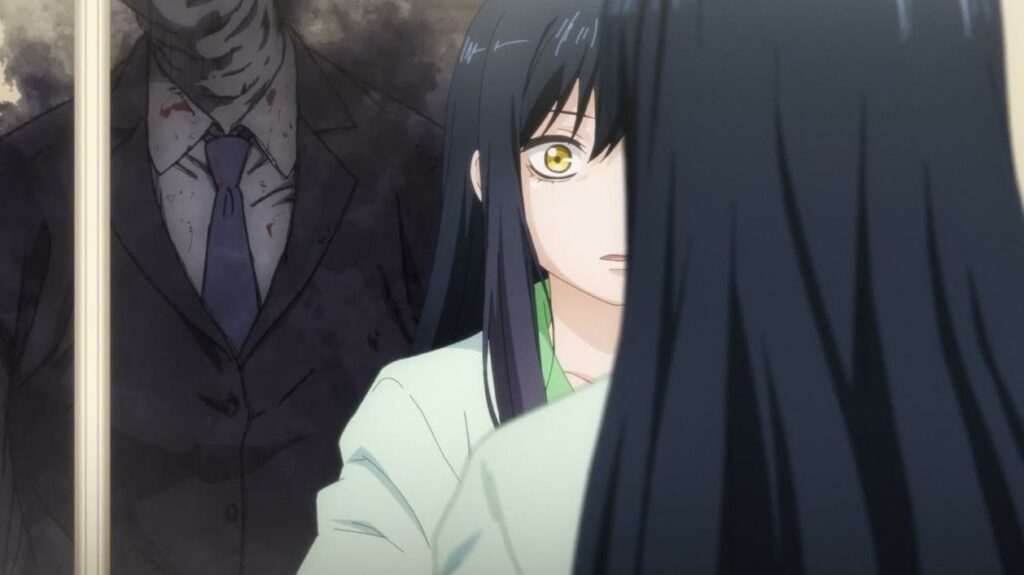
The frame conveys several elements at once. The main focus is immediately turned to Miko. The contrasting expression of “shocked or “fear” with the still image of the back of the head expresses a ton. She can for one see the haunting image; two is either too scared to move, or brave enough to not back down entirely. The audience will learn more about her as we watch but at the moment it’s a quick glance into her personality.
The next part of the note in the shot is the ghost with a sinister aura. We have another stark contrast here as the colors of the ghost compare with the environment. Miko’s clothes as well as the background represent living and reality. They are bright and stand out, especially against the ghost who emanates a black cloud around them. The dark suit combined with the gray dead skin represents the absence of life and helps highlight the overall tone of the show in one frame.
Tone setting in limited shots
However, what is most impressive is being able to convey multiple elements with limited framing. In the prior scene before this, Miko spent some good time searching for something under a desk that really shows off her figure. However here in the next shot, we see only Miko in a hallway with some notes on a board in the foreground. This is a simple close-up shot that simultaneously does a great job of setting a tone.
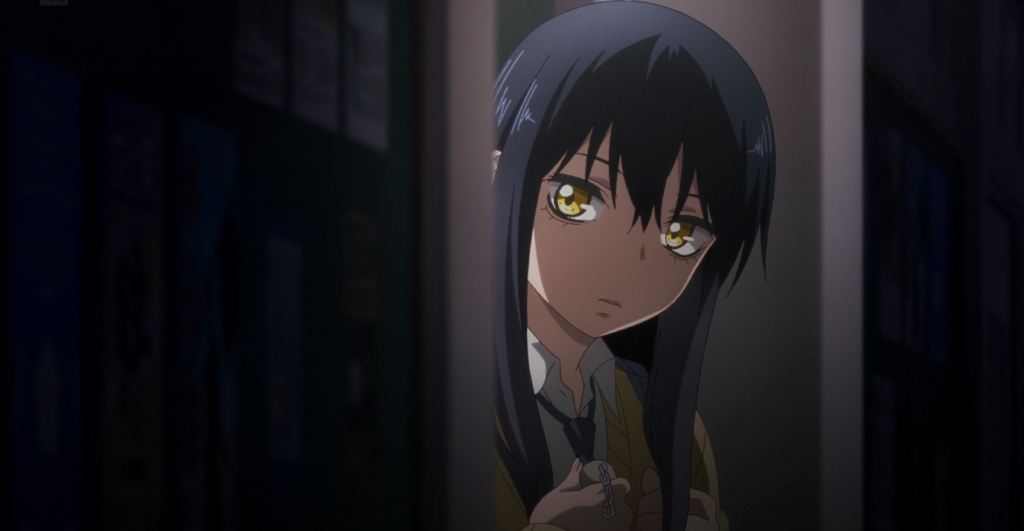
At this point, we have had no direct supernatural interactions or sightings. All we have had to this point is allusions to something strange happening around Miko. So right before this, we had a very quick sighting of a shadow moving. While the viewers begin to see this and start to brace themselves, Miko does not. Here we get a few strategies like the situational irony that Mieruko-chan’s director employs to amplify the growing sense of unease.
Excellent Use of Lighting
Firstly, the attention is to Miko in the middle, and she commands the attention for 2 reasons. For one, she is the focus of the shot, and the more you pan out, the blurrier it gets. This is also because of the lighting, as it comes from behind and over her. Her position is leaning forward, seemingly peeking out. This causes a shadow effect on her face and darkens the only person with light herself. This is to create a sense of isolation, and growing fear. She is the only thing remotely with light and even she is growing darker.
Ogawa‘s camera work does a fantastic job of keeping the show in focus. It helps keep the tone and mood present, even when the situation may not be as relevant. Great cinematography like this keeps an audience on edge so even when there is a seemingly normal conversation or a close-up of characters’ best features, we still feel a sense of unease.
Interspecies Reviewers (2020)
While Ogawa’s current work is what’s making noise, he has shown his impressive abilities on other fronts. Ishuzoku Reviewers, or Interspecies Reviewers, is an adult comedy centered on a group of young men. As the name implies, they set out across their world interacting with various other magical races. Long story short, when they return to their town, they write about their interactions on the local Bulletin Board so others can learn about what it’s like as a traveler.
For a show that is thematically a comedy with multiple slapstick moments already, we need to convey a completely conflicting message now. Here in this shot, the boys are hanging out at the inn after publishing their most recent escapade. Meidri, the bartender, is not particularly thrilled to read their work.
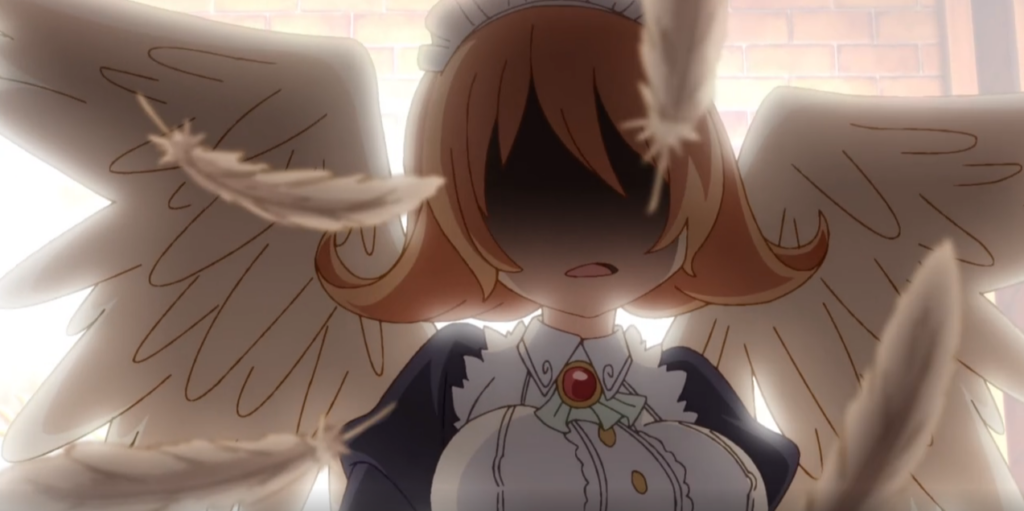
Thematic Change with Cinematography
So how do you manage to show how upset she is? Here in this close-up shot, we get several rage alluding elements. Firstly, the background is white and this achieves 2 things. It makes Meidri the focal center point of the shot as the lighting from behind highlights her blinding the surroundings. Also, it also represents Divine retribution, as she now looks like an angel of justice with her beautiful figure and bird wings present.
Lastly, we have hidden eyes and this is my favorite trope in anime cinematography. A director would use this type of shot so that the character in question is hiding how they truly feel. You can’t achieve this in live-action, so a great way to express absolute rage or disgust is to blacken the top half of the face. This does a great job in a limited capacity to provide a super drastic change in tone so the audience can understand when something is serious. So Mieruko-chan’s director does phenomenally to reset the tone properly when prompted.
My First Girlfriend is a Gal (2017)
Ogawa Yuki has done some really great work on establishing a theme and tone. These crucial elements are massive for making sure there is a meaning. If you cannot properly convey the story you want to tell, there is no point. However, camera work, cinematography, and directing go far beyond just these elements.
As an assistant director and storyboard contributor for My First Girlfriend is a Gal, Ogawa helped director Aiura Kazuya orchestrate a great framing for the series. This show focuses on the main character Jun`ichi, and his crush turned girlfriend, Yukana. Throughout the series, we never really stray from close-up shots, creating a more intimate setting. So something that Mieruko-chan‘s director does in this role here that I truly appreciate is adjusting the frame to involve the viewer while showcasing a character’s best qualities.
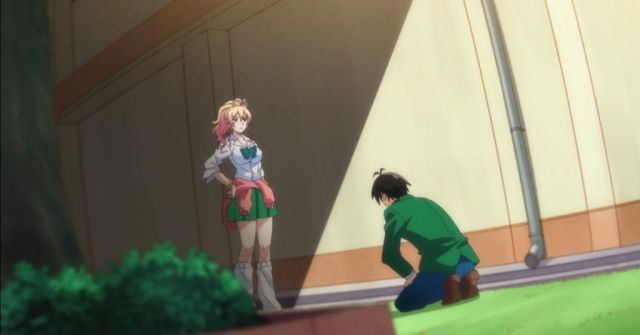
Situational Framing
In this one moment, we get a wide shot with a slight dutch angle. In this setting of the first episode, Jun`ichi has just asked out one of the more popular girls in school and it is obviously going well. The orientation of the camera sets clear to moment hierarchy. Yukuna stands over him as he prostrates himself. The camera is also at an angle so that we can clearly see her looking down on him literally and figuratively.
Also, the lighting of this is shot interesting itself. We can perceive this in one of a few ways. For one, it’s possible to represent a good and evil approach. That Yukana stands in the shadows as someone shady in character while Jun’ichi kneels in the light as a hero of some form. Or, more likely, it acts as a signal that the main character is a good person, and will redeem himself from this moment of subjugation.
In any form of film, a director and their team can take multiple approaches to showcase their vision. So in this show, the first episode establishes a recurring theme about subverting expectations. We see the main protagonist as a sleazy person at first, but that he has a good heart. Yukana is described by descriptions in a certain way, but see that her character is something else entirely. The framing of this shot helps establish the base goal of changing perceptions, and Yuki Ogawa assists that in a great way.
Saekano: How to Raise a Boring Girlfriend (2015)
Lastly, something that is very important in a show or film is expressing emotion. This is something especially important when complicated situations arise. For instance, if someone is at a funeral, but they themselves are happy. The background may be brighter. Conversely, if the scene is a festival and the characters are actually sad trying to hide it. While they might smile, externally the background would be more grey diluting the colors around them.
Beginning Role as Director/2nd Key Animator Role
Mieruko-chan’s director Ogawa Yuki is listed as Director and also 2nd key animator for several episodes of Saekano. A key animator is an artist responsible for producing the principal keyframes of an animation. Basically, key animators structure the vital frames that mark a distinct position or expression of a character in a particular scene. As 2nd Key animator, Ogawa worked with the key animation team to refine the frames for the best product.
You can see a lot of his style in these episodes as he was quoted from the same interview previously mentioned stating what he learned from the series director, Mikita Kamei. “I think the first thing I used to see [Mikita Kamei], doing in How to Raise a Boring Girlfriend (2015) was the first time I used it as a reference for my own content, such as reflecting angles from the bottom to the top and pulling a little from the cleavage of my chest to show the character.”
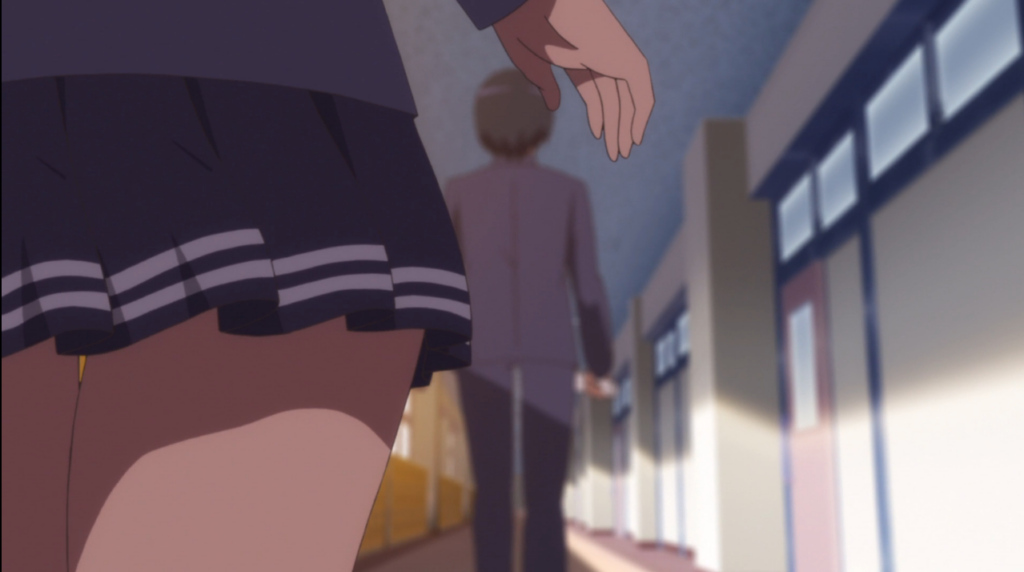
Beginning Signs of His Style of Directing
Listed in episode 2, this was Yuki Ogawa’s first episode in charge of Saekano, and he attempts to set the tone here. This frame holds several elements. Firstly this is a two-shot, meaning there are 2 subjects. Medium shot so that it is from the knees up on the focal subject. Lastly, it contains tilt-shift so that one part of the image is in focus, while the other is blurry.
This is all done to do several things, one of which is to show off a very attractive female character. So in this frame, the girl’s identity is actually unknown. Previous scenes of her approaching were only ground shots so we actually don’t know much about her. She has more of her body revealed as the scene progresses so that it doubles as a character reveal, as well as a moment to appreciate the well-drawn physique of the character.
Conclusion
Art is extremely subjective; however, what is not is an artist’s intention. No matter what you perceive as a viewer, Ogawa clearly has an intended vision. He seemingly wants to balance the themes of the show, while also servicing the fans. This type of style is not something everyone can do successfully, or even attempt at that. So his unique framing and cinematography will excite fans, and keep people looking forward to more episodes.
Fans can look forward to more similar work from Mieruko-chan’s director in coming episodes and can vote to support the anime in our weekly polls.
Akiba Institute, Ogawa Yuki interview
Translations provided by Bushido Samurai
Featured images: ©泉朝樹・KADOKAWA刊/見える子ちゃん製作委員会












Leave a Reply